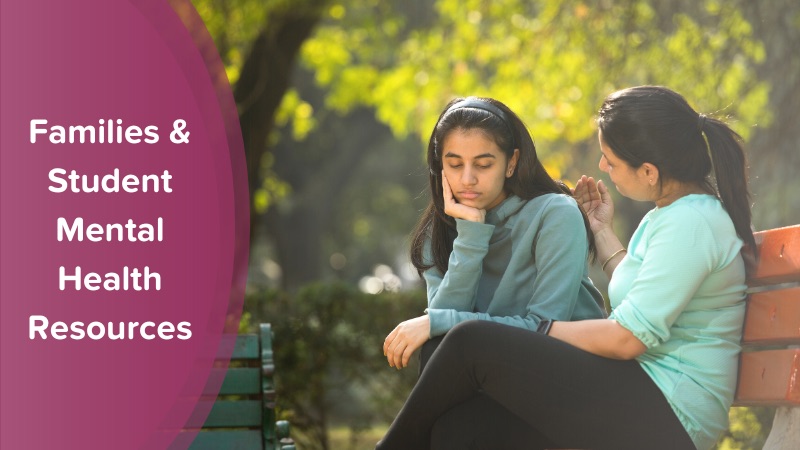By Rebecca Honig, chief content & curriculum officer, and Megan Okrand, contributing writer
Like many, I find myself scrolling through social media probably too often. Yet, amidst the memes and cat videos, I’ve come to appreciate the unexpected wealth of knowledge these platforms offer. From learning a new recipe to diving deep into historical events (what can I say, the algorithm knows I’m a former history teacher), social media has proven to be a surprisingly rich educational resource.
But perhaps most intriguing is the way it has become a haven for teens and adolescents navigating the complexities of mental health, serving as a gateway to invaluable student mental health resources.
In recent years, there has been a noticeable shift in how students approach their mental well-being. Access to online platforms and resources has played a pivotal role in this shift, providing a wealth of information on topics ranging from anxiety and depression to stress management and emotional well-being.
Increased Self-Awareness and Advocacy Among Students
A lot of evidence suggests that today’s students are more attuned to mental health issues than any previous generation. With an abundance of information available, young people are becoming increasingly self-aware and educated about mental health issues. This heightened awareness has empowered many students to become self-advocates for their mental health needs — a development that, while positive, has introduced new dynamics and concerns within families.
For many parents, witnessing their children navigate complex mental health information online and take proactive steps towards managing their well-being can be a source of anxiety. Concerns arise over the accuracy of the information their children are accessing and whether this self-directed approach to mental health care is adequate and appropriate.
The approach to mental health also varies significantly across different generations and cultures. Previous generations may have grown up with a stigma surrounding mental health discussions, leading to a reluctance to seek help or even acknowledge mental health issues. In contrast, many young people today view mental health as an integral part of overall well-being, openly discussing and seeking support for their mental health needs. This shift in openness about mental health is crucial in addressing the broader mental health crisis affecting students nationwide.
This generational divide underscores the importance of extending student mental health resources to encompass the whole family. By providing resources that are accessible and relevant to parents and caregivers, schools and communities can bridge the gap in understanding and support, fostering a more inclusive and supportive environment for addressing mental health.
Youth mental health is the “springboard of thinking and communication skills, learning, emotional growth, resilience and self-esteem.”
U.S. Surgeon General’s Report on Youth Mental Health
Mental health advocacy starts with social emotional learning
Social emotional learning (SEL) must be at the heart of our educational endeavors as we move forward in this new era of mental health awareness. Recognizing the pivotal role of parents and caregivers in this process is essential, as they are instrumental partners in both fostering the emotional and social development of children and providing mental health support.
In collaborating with families to ensure comprehensive SEL support for both children and adults, consider integrating resources and strategies that:
- Empower parents and caregivers to model and teach SEL skills within the family setting.
- Provide accessible, engaging activities that families can incorporate into their daily routines.
- Offer guidance on creating a supportive home environment where children feel valued and understood.

By focusing on these areas, we can enhance the effectiveness of SEL initiatives, making a lasting impact on the mental health and well-being of students and their families.
As educators partner with families to make sure that both children and grownups get the social emotional learning support they need, here are some things to consider and resources that may help.
1. Bring in parent voices to understand student mental health
Parents have so many insights to share. Insights about how their child is doing, about how their child is feeling. About their hopes and dreams for the year to come, and about their fears.
To access those insights, look for opportunities to hear parent voices. For example, you might bring families together virtually to learn together, share insights and share strategies. Check out this webinar where we detail how to host a virtual family engagement event specifically designed to maximize parental participation.
Moreover, these interactions can serve as a pivotal platform for parents to voice their concerns or initiate conversations with school counselors. This direct line of communication allows parents to seek guidance on navigating their child’s mental health challenges at home, ensuring a collaborative approach between schools and families. Such collaboration is essential in creating a supportive network that addresses student mental health effectively.
2. Encourage open communication and active listening
While often parents can provide insightful information about their child’s mental health, they may sometimes struggle with how to best communicate with their children about these sensitive topics — and that’s okay! Navigating conversations around mental health issues can be challenging. Parents may fear saying the wrong thing or may not know how to start such a dialogue.
Recognizing the importance of supportive dialogues in navigating mental health, student mental health resources have evolved to include communication guides specifically designed for parents and their teens or adolescents. These comprehensive resources aim to break down barriers that may exist between family members, facilitating open and supportive conversations. They offer valuable talking points, strategies, and questions that encourage children to share their feelings and experiences, ensuring that families have the tools they need to support one another effectively.
By providing parents with the right tools, we can empower them to approach conversations about anxiety, depression, and other mental health challenges with confidence and sensitivity. These guides can cover a range of topics, from identifying signs of mental health problems to understanding how to support a child experiencing emotional stress or suicidal ideation.
Incorporating strategies into these guides that promote active listening and empathy can significantly impact how these conversations unfold. Parents can learn how to create a safe and non-judgmental space for their children to express themselves, ensuring they feel heard and supported. Offering examples of open-ended questions that encourage deeper reflection and sharing can also be beneficial, as it invites children to explore and articulate their feelings in a supportive environment.
3. Give parents a little bit of tech support
Navigating the world of social media and internet use has become a significant aspect of teenagers’ lives. The link between student mental health and technology use isn’t black and white; it’s a complex mix that goes beyond labeling it as purely good or bad.
As we’ve noted, the digital realm offers unparalleled access to mental health resources and communities where young people can find solace and understanding. However, it’s essential to balance this with awareness of the challenges posed by social media.
The U.S. Surgeon General’s Advisory on Youth Mental Health brought to light a concerning statistic: teens who spend over three hours a day on social media are twice as likely to exhibit depression and anxiety symptoms. Additionally, a study from JAMA Psychiatry in 2019 found a marked decrease in life satisfaction among adolescents with higher social media usage, particularly among younger girls and boys in their early teens.
This backdrop makes it clear that, while social media can be a lifeline for teens feeling isolated, the key to harnessing its benefits lies in cultivating healthy technology habits. Misinformation, the potential for misdiagnosing a mental health concern and the intense scrutiny of personal lives on these platforms can exacerbate mental health issues, highlighting the need for guidance in navigating the digital space.
ParentPowered steps in with resources aimed at helping families guide their teens towards positive and safe technology use. Encouraging conversations about the content they consume, setting boundaries around screen time, identifying credible mental health information, and cultivating offline connections are pivotal steps in ensuring that technology serves as a tool for mental wellness rather than a source of distress.
4. Connect families with the essentials in supportive ways
Managing stress and anxiety is a challenge, especially when basic needs are unmet. It’s one thing to know help is out there, but reaching out and accessing it is another hurdle entirely. For families looking to support student mental health, finding the right resources and support systems is a critical first step.
These strategies for connecting families with basic needs and assistance programs, derived from our extensive experience in connecting families with basic needs and assistance programs, serve as an excellent foundation. They are a core component of ParentPowered Trauma-Informed, designed to ensure families have the support and resources necessary to navigate life’s challenges effectively.

Empowering teens to advocate for their own mental wellbeing positions them to better manage their mental health, both now and in the postsecondary world. Resources such as through campus counseling centers in colleges or universities provide tailored support for students facing mental health challenges and facilitate connections to appropriate services for timely support. Furthermore, educators and staff are equipped to identify signs of distress and guide students to necessary mental health resources, establishing a crucial link between students and the assistance they need, thereby encouraging a culture of self-care and advocacy that extends into their future.
It’s important to note some of the biggest hurdles — cost and finding the right help — can stop young people from getting the mental health care they need. This is where the availability of both school-based and home-based mental health resources becomes essential. These resources are designed to ensure that seeking help doesn’t seem like an insurmountable challenge, alleviating concerns about cost and simplifying the process for students to ask for assistance.
5. Focus on family strengths for at-home SEL activities
We set parents and caregivers up for success when you leverage their strengths. We want parents to read any social emotional learning tips or activities and think, “I can do that!”
To achieve this, educators may:
- Layer activities onto things that families are already doing and resources that they already have.
- Use accessible terms and language.
- Make sure support and suggestions they offer reflect the lived experiences of families.
- Offer ideas that celebrate families’ cultures and unique identities.
Here are two webinars as resources, one focused on strategies for reaching families in strength-based ways and the other highlighting SEL supports that we think are especially user friendly.
By embracing at-home SEL activities, families can create a nurturing oasis that not only celebrates their unique cultures but also bolsters the emotional resilience and social connections of students grappling with mental health challenges.
These activities, rooted in everyday family life, offer safe spaces for their students to voice their feelings, fortify trust, and learn vital coping strategies amidst warmth and love. Such a supportive environment is instrumental as students navigate the complexities of their emotional landscapes, by fostering a robust sense of belonging and bolstering them as they prepare to face the world’s challenges.
6. Apply a culturally competent and trauma-informed lens
The path to supporting student mental health is paved with compassion, empathy, and a deep commitment to inclusivity. Recognizing that mental health is a deeply personal experience, it’s important that our schools and support services offer a safe, inclusive space where every student and family feels seen and supported, no matter their background.
For Black students and students of color, the conversation around mental health takes on additional layers, with intersectionality playing a key role in their experiences. Educators are becoming increasingly aware of the complex ways in which racial and cultural identities can influence mental health experiences. These young people navigate their world at the intersection of race, culture, and mental health, confronting unique mental health problems that call for a nuanced and culturally aware approach to mental health care.
Incorporating a culturally informed lens into mental health services transforms how schools and mental health professionals engage with and support students. It’s about ensuring that school counselors and educators are prepared to offer support that resonates with the lived experiences of all students, making mental health care accessible to everyone.
Additionally, integrating trauma-informed care into student mental health represents a significant move towards healing and understanding. This approach recognizes the broad range of traumas affecting students’ mental health and academic outcomes. By extending to the whole family, it acknowledges that trauma impacts family systems, not just individuals. Trauma-informed programs like the one offered by ParentPowered in schools empower families with resources and support, turning mental wellness into a collaborative journey.
7. Celebrate self care for adults, too!
That means educators and families both! The more we grownups take care of ourselves, the better we’ll be able to support the social and emotional needs of children.
Caring for ourselves in a world that constantly asks more from us as educators and of families as caregivers is not just a luxury — it’s a necessity. Self-care is a profound lesson in self-respect and resilience for children, showing them that taking time for oneself isn’t selfish but essential for maintaining mental health.

In the hustle of daily life, it’s easy to forget that our mental health needs as much attention as our physical health. By adopting educator and parental self-care practices, we’re not only looking after ourselves but also setting a powerful example for students and their families. This act of balance teaches them the importance of emotional stress management and building resilience against life’s ups and downs.
8. Reach out for support
It may be challenging for families to ask for help. The maze of decisions — knowing who to turn to, finding the right words, and managing follow-ups — can seem even more daunting when families and educators both are already carrying the weight of the world.
Educators can support their families and students to make reaching out feel less overwhelming with these strategies:
- Share information about local mental health services and professionals to help families determine what support they may need to address concerns, whether it’s through school counseling centers, health insurance networks, or local mental health organizations.
- Consider offering support groups and campus counseling centers for both teens that understand the unique pressures of young people today, from social connection struggles to depression and anxiety.
- Model resilience by embracing opportunities to build meaningful connections with families. Relationships are essential components of mental wellness for educators, students, and families alike.
For more tips, check out ParentPowered’s Reaching Out resource.
Embracing a future of comprehensive student mental health resources
The landscape of student mental health is undergoing a transformative shift, marked by an increase in self-awareness and advocacy among young learners. This evolution, while presenting its set of challenges, notably parental concerns over navigating the vast sea of information, heralds a new era of openness and understanding around mental health. As we move forward, there’s an unparalleled opportunity to cultivate an environment where discussions on mental health are not just welcomed but encouraged.
This comprehensive approach aids in supporting students through their mental health challenges, ensuring they have the backing they need to address or overcome anxiety, depression, suicidal thoughts, and other mental health concerns. What’s more, this approach is designed to serve not just students but their families as well, ensuring that everyone is equipped to face mental health challenges with confidence and resilience.
At ParentPowered, we’re committed to being a part of this positive change. Our curricula are crafted with the understanding that student mental health is a pivotal part of their success both inside and outside the classroom. Request a demo today to see how we address student mental health and SEL.
About the authors
Rebecca Honig is the Chief Content and Curriculum Officer at ParentPowered. She has authored numerous curricula, parent guides, and children’s storybooks for Sesame Workshop, Scholastic, Disney, Compass Learning, PBS, WGBH, HITN, Nickelodeon, Mo Willems, and The Norman Rockwell Museum. She has also served as a Curriculum and Content Specialist for Sesame Street and spent ten years teaching in public, private, and after school programs. Rebecca has a Master’s Degree in Early Childhood Education from Bank Street.
Megan Okrand is a former High School History teacher turned writer taking her passion for education outside of the classroom and into the World Wide Web. Megan holds a master’s degree in secondary education and teaching from the University of Southern California as well as a master’s degree in art history, criticism, and conservation from University of North Carolina, Chapel Hill. Connect with her on LinkedIn.









